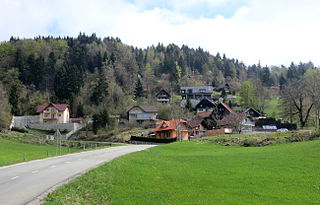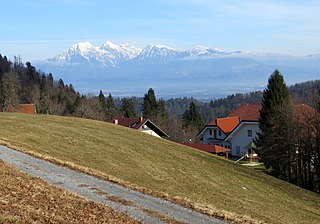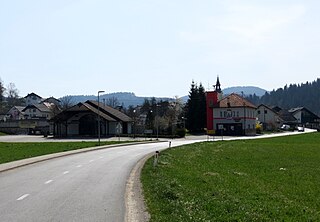| Primož Sveti Primož (until 1955) | |
|---|---|
| Coordinates: 45°58′12.68″N15°17′41.91″E / 45.9701889°N 15.2949750°E Coordinates: 45°58′12.68″N15°17′41.91″E / 45.9701889°N 15.2949750°E | |
| Country | |
| Traditional region | Lower Carniola |
| Statistical region | Lower Sava |
| Municipality | Sevnica |
| Area | |
| • Total | 0.64 km2 (0.25 sq mi) |
| Elevation | 536.7 m (1,760.8 ft) |
| Population (2002) | |
| • Total | 25 |
| [1] | |
Primož (pronounced [ˈpɾiːmɔʃ] ; German : Sankt Primus [2] ) is a small village in the hills south of Boštanj in the Municipality of Sevnica in central Slovenia. The area is part of the historical region of Lower Carniola. The municipality is now included in the Lower Sava Statistical Region. [3]

German is a West Germanic language that is mainly spoken in Central Europe. It is the most widely spoken and official or co-official language in Germany, Austria, Switzerland, South Tyrol (Italy), the German-speaking Community of Belgium, and Liechtenstein. It is also one of the three official languages of Luxembourg and a co-official language in the Opole Voivodeship in Poland. The languages which are most similar to German are the other members of the West Germanic language branch: Afrikaans, Dutch, English, the Frisian languages, Low German/Low Saxon, Luxembourgish, and Yiddish. There are also strong similarities in vocabulary with Danish, Norwegian and Swedish, although those belong to the North Germanic group. German is the second most widely spoken Germanic language, after English.

Boštanj is a village in the Lower Sava Valley in southeastern Slovenia. It consists of a nucleated centre on two terraces on the right bank of the Sava River along the main road from Celje to Krško, and two hamlets, Puše and Redna, on the slopes of the nearby hills. It is the central settlement of the Local Community of Boštanj, the largest local community in the Municipality of Sevnica. The village has a post office, a fire station, a primary school, two shops, a gas station, two bars, a restaurant, and a cultural hall named the TVD Partizan Hall. It is surrounded by fields and orchards.

The Municipality of Sevnica is a municipality along the Sava and the Mirna Rivers in southeastern Slovenia. The seat of the municipality is the town of Sevnica. Today it is part of the Lower Sava Statistical Region. It is the 12th-largest municipality by area in Slovenia.













